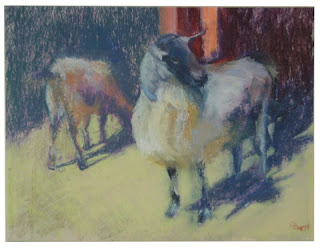This is a question that people ask painters, including other painters.
Did I go to school for art? Well, I thought I did but I didn't find much. Thanks to the fact that I chose design as my major, I found good beginnings in color, design, and drawing. As for painting, I did not learn much. Illustration was a part of our program, but a very weak link with an instructor who had a narrow view of what illustration should be. People who had a strong start in a good high school art program did well, but I lacked that too!
I wanted to paint realistically which just wasn't in favor at that time. In my art history class I discovered paintings by artists whom I admired and I knew where I wanted to focus but I didn't know how to get there. I was drawn to Vermeer, Hieronymus Bosch, Pieter Bruegel and most of all, Edgar Degas. I have different favorites now, but Degas is still top of my list.
To learn to paint the way I wanted to, I "took art" from anyone who would give it to me. I took recreation center classes from local artists, Alice Bess and Dot Nowell, who gave generously of all that they had learned and encouraged me with no limits. This is where I learned basics about materials, how to mix color, find the light source in the painting, and to keep trying. They also gave me the courage and taught me how to enter shows, frame my work, display my work at art shows and, again, to keep trying. Don't give up if you are rejected from a show - just keep painting
until you get good enough and you will be accepted.
Later on I took workshops from nationally and internationally
known artists, who often told me things I wasn't ready to understand. I
kept hearing the same things over and over from many wonderful artists
and eventually I was ready to hear them and it clicked.
Susan Lyon - a fantastic artist and great teacher - with whom I have
been fortunate enough to study, taught more than I could absorb at once.
I think I'll need a refresher course with her!
Here are some photos of demo by Susan and the still life set up we worked from.
Now I understand more than I used to, but have to keep reminding myself to make use of the things I have learned, which is pretty difficult. I am still learning and don't intend to ever stop going to school for art! You can learn so much in a week long workshop - way more than you can absorb in that amount of time. Then the hard part comes; go home and paint, paint paint til you perfect it.



















































